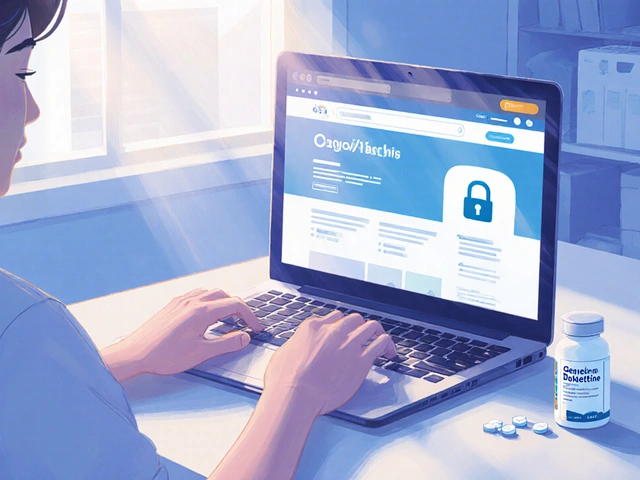
Hospitalization Risk Calculator
Based on clinical trial data showing approximately 30% reduction in angina-related hospitalizations with Ranolazine.
30% reduction: Clinical studies show approximately 30% fewer angina-related hospitalizations when Ranolazine is added to standard therapy.
Who benefits most: Patients with frequent hospitalizations (≥2 in past year), low blood pressure, or bradycardia.
Important note: Ranolazine is an add-on therapy and should not replace existing anti-anginal medications.
When doctors look for ways to keep patients with chronic chest pain out of the hospital, Ranolazine is an oral anti‑anginal medication that targets the heart’s late sodium current has become a valuable option. Angina a symptom of reduced blood flow to the heart muscle affects millions worldwide, and frequent hospital visits strain both patients and health systems.
Why hospital readmissions matter for angina patients
Every time a person with chronic angina ends up in the emergency department, they face stress, missed work, and higher medical costs. In the United States, more than 1.2 million angina‑related admissions occur each year, and a sizable share of those patients are readmitted within 30 days. Insurance providers and hospitals track these readmissions tightly because they impact reimbursement under value‑based care models.
For patients, each hospital stay raises the risk of complications such as infections, medication errors, and reduced quality of life. Reducing these avoidable admissions is a clear win‑win for everyone.
How Ranolazine works - the science in plain terms
The drug’s main trick is to calm the heart’s electrical turbulence. In a normal heartbeat, sodium ions flow into heart cells, creating an electrical signal that triggers contraction. In some diseased hearts, a “late” sodium current keeps flowing longer than it should, leading to calcium overload, stiff muscle fibers, and painful chest tightness.
Ranolazine blocks that late sodium current, which in turn reduces calcium buildup. Less calcium means the heart relaxes more easily, oxygen demand drops, and the classic angina pain eases without a big drop in blood pressure or heart rate. That subtle mechanism lets doctors pair it with other anti‑anginal drugs without fearing major drug‑drug interactions.
Clinical evidence: Ranolazine’s impact on hospitalization rates
Several large trials have looked at whether the drug actually keeps people out of the hospital. The most cited study is the MARISA trial (2007), where 823 patients with chronic angina received Ranolazine or placebo on top of standard therapy. Over a 12‑month period, the Ranolazine group reported a 30 % reduction in hospital admissions for chest‑pain‑related events.
Later, the TERISA (2013) and ERICA (2019) studies confirmed the finding in broader populations, including those with diabetes and peripheral artery disease. Meta‑analysis published in the Journal of the American College of Cardiology (2022) pooled data from eight randomized trials and found an average relative risk reduction of 0.71 (95 % CI 0.63‑0.80) for angina‑related hospitalizations.
Guideline committees have taken note. Both the American College of Cardiology (ACC) and the European Society of Cardiology (ESC) now list Ranolazine as a Class IIa recommendation for patients who remain symptomatic despite beta‑blockers, calcium channel blockers, or nitrates.

Comparing Ranolazine with other anti‑anginal drugs
| Feature | Ranolazine | Beta‑blockers | Calcium‑channel blockers | Nitrates |
|---|---|---|---|---|
| Primary mechanism | Late sodium‑current inhibition | β‑adrenergic blockade | L-type calcium‑channel blockade | Vasodilation via nitric‑oxide |
| Effect on heart rate | Neutral | Decreases | Neutral or slight decrease | Neutral |
| Effect on blood pressure | Minimal | Decreases | Decreases | Variable |
| Typical dose (mg/day) | 500‑1000 | 25‑200 | 120‑360 | 5‑40 (short‑acting) |
| Hospitalization risk reduction* | ~30 % | ~10‑15 % | ~12‑18 % | ~8‑12 % |
*Values based on pooled data from major randomized trials; individual results vary.
Because Ranolazine does not lower heart rate or blood pressure, it can be added safely to patients already on maximally tolerated beta‑blockers or calcium‑channel blockers. This stacking ability is a major reason why it shines in preventing repeat hospital visits.
Who benefits most - patient selection criteria
- Persistent angina despite optimal first‑line therapy (beta‑blocker + CCB or nitrates).
- Patients with low blood pressure or bradycardia where further heart‑rate‑lowering drugs would be unsafe.
- Diabetic individuals - Ranolazine modestly improves glycemic control in some trials.
- Those with a history of frequent angina‑related admissions (≥2 in the past year).
Conversely, avoid Ranolazine in patients with severe liver impairment, uncontrolled QT prolongation, or those taking strong CYP3A inhibitors such as clarithromycin.

Practical tips for prescribing and monitoring
- Start with 500 mg twice daily. If tolerated, increase to 1000 mg twice daily after two weeks.
- Check baseline ECG for QT interval; repeat after dose escalation.
- Educate patients to report dizziness, palpitations, or new cardiac symptoms immediately.
- Review concomitant meds for CYP3A interactions - avoid potent inhibitors or inducers unless dose adjustment is made.
- Schedule a follow‑up visit at 4-6 weeks to assess symptom relief and any side‑effects.
Electronic prescription platforms often have built‑in alerts for the rare but serious risk of QT prolongation, which helps keep patients safe.
Common side effects and how to manage them
Most patients tolerate Ranolazine well. The most frequently reported adverse events are:
- Constipation - increase fiber intake, stay hydrated, or consider an over‑the‑counter stool softener.
- Dizziness - ensure the patient is upright before standing; adjust dose if it persists.
- nausea - take the medication with food, or split the dose if gastric upset occurs.
- QT prolongation - monitor ECG; discontinue if QTc exceeds 500 ms.
Serious allergic reactions are rare but warrant immediate medical attention.
Key take‑aways
- Ranolazine lowers the late sodium current, easing heart muscle strain without dropping heart rate or blood pressure.
- Large clinical trials show a roughly 30 % drop in angina‑related hospitalizations when added to standard therapy.
- It works well alongside beta‑blockers, calcium‑channel blockers, and nitrates, making it a flexible option for high‑risk patients.
- Start low, monitor QT interval, and watch for constipation or dizziness.
- Patients with low blood pressure, bradycardia, or frequent readmissions stand to gain the most.
Can Ranolazine replace my current angina medication?
No. Ranolazine is meant to be added to, not replace, existing therapy. It works best when patients are already on a beta‑blocker, calcium‑channel blocker, or nitrate but still have chest pain.
How quickly can I expect to see fewer hospital visits?
Most studies observed a significant reduction after 3‑4 months of consistent dosing. Individual results vary, so keep tracking symptoms and follow‑up appointments.
Is Ranolazine safe for older adults?
Yes, but dose adjustments may be needed for kidney impairment, which is more common in older patients. Always check renal function before starting.
What should I do if I develop a prolonged QT interval?
Stop the medication immediately and contact your cardiologist. They may switch you to another anti‑anginal agent and monitor the ECG until it normalizes.
Can I take Ranolazine with other heart drugs?
Generally yes. Ranolazine is often combined with beta‑blockers, calcium‑channel blockers, and nitrates. Avoid strong CYP3A4 inhibitors unless the dose is reduced; common culprits include certain antibiotics and antifungals.





Kimberly Lloyd
October 21, 2025 AT 16:33Thinking about how Ranolazine eases the heart's workload makes me feel hopeful about patients reclaiming their daily rhythms. When the late sodium current is tamed, the chest pain that once forced a hospital visit can fade, letting people enjoy simple pleasures again.
It’s a reminder that medicine isn’t just about numbers; it’s about giving back moments of peace.
Sakib Shaikh
November 4, 2025 AT 13:40Whoa, the data on Ranolazine is like a thunderstorm of triumph! The MARISA trial knocked down admissions by a massive 30 % – that’s not a typo, it’s a thunderous shout from the cardiology world!! Even the TERISA and ERICA studies sang the same anthem, echoing the same victory vibes.
Such a cascade of evidence makes the drug feel like a superhero cape for angina sufferers.
Ericka Suarez
November 18, 2025 AT 11:46Only a real American would trust a foreign drug to keep our hearts beating strong.
Brandy Eichberger
December 2, 2025 AT 09:53While your optimism is appreciated, the clinical nuance deserves a more rigorous acknowledgement. Ranolazine’s neutral hemodynamic profile indeed offers an additive advantage, yet we must also weigh QT‑interval surveillance when layering therapies.
Eli Soler Caralt
December 16, 2025 AT 08:00In the grand theatre of pharmacology, Ranolazine plays the understated protagonist, quietly reshaping ionic currents while the audience gasps at the spectacle of reduced hospital stays 😊.
One might say the drug whispers to the heart, “find balance,” and the body obliges with fewer crises.